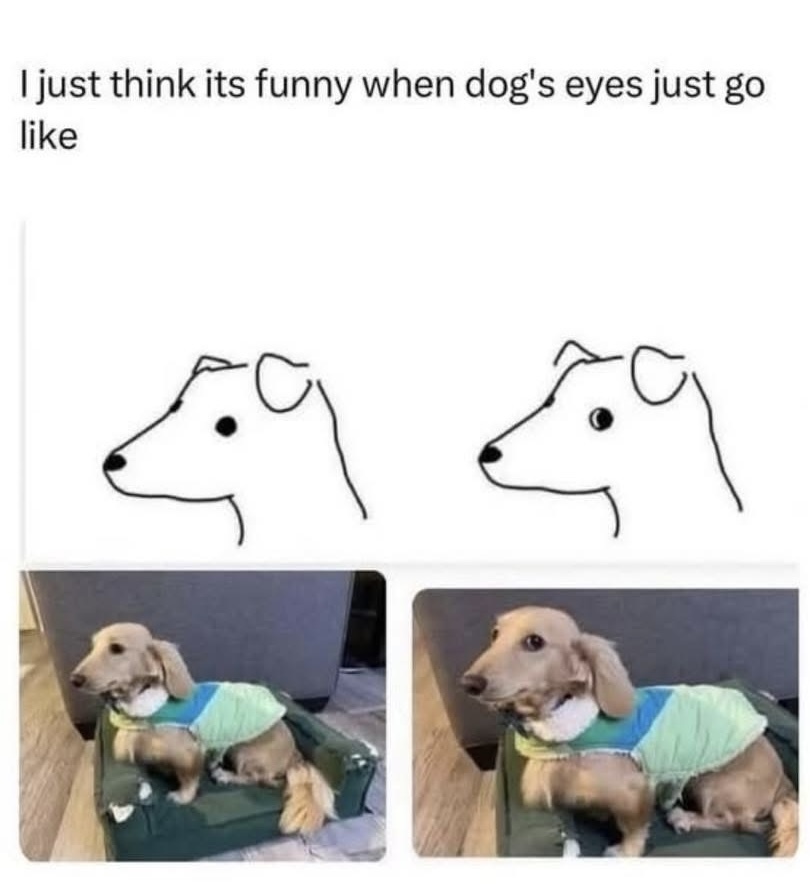this post was submitted on 08 May 2025
410 points (98.6% liked)
Dogs
4971 readers
52 users here now
A community about dogs.
Breeds, tips and tricks about training and behaviour, news affecting dog owners, canine photography, dog-related art and any questions related to dog ownership.
Rules
- Posts must be related to dogs or dog ownership and must not be void of content.
- This is a neutral space. No bigotry or personal attacks. Criticism should be polite and constructive.
- No automated content. This includes AI generated imagery, post body, articles, comments or automated accounts.
- No advertising or self-promotion.
- Illegal or unethical practices are frowned upon, and any comments or posts suggesting them will be removed. This includes, but is not limited to, backyard breeding, ear and tail cropping, fake service animals, negative reinforcement, alpha/pack/dominance theory, and eugenics.
- No judging or attacking community members who care for dogs with cropped ears, docked tails, or those from puppy mills or questionable sources. While we discourage these practices (per Rule 5), all dogs deserve loving homes and compassionate care regardless of their background or physical alterations.
- No breed discrimination, all breeds welcome. Our stance matches the ASPCA's official stance and is not up for debate.
- Citing your sources when making a claim is encouraged. Misinformation will be removed.
founded 2 years ago
MODERATORS
you are viewing a single comment's thread
view the rest of the comments
view the rest of the comments

Many people say this is a half-moon eye or whale eye, and it is, yet there is probably not enough context to prove what it means in this photo.
Like all dog body language, one signal is not always enough to determine a dog's real emotions. This is why many dog body language signals are called meta-signals, which you can guess by their name: signals about signals. Multiple signals create a total that might be different from some of the individual signals being made.
Imagine playing with a dog, tugging on a toy, and having them growl and show whale eye. Someone might say, "That dog has half a moon or a whale eye! They are upset!" Meanwhile, the dog's body is loose, sneezing, its elbows are bent, and its tail lazily wags. When you stop tugging, they take your cue and stop tugging as well.
Assign a value to their mood, where 0 is neutral, a negative number is a negative emotional expression like growling, whale eye or lip licking and a positive number is associated with positive body language. Let's add that up: whale eye -1, growl -1, loose body +1, sneezing +1, elbows bent +1, tail wags +1, following along +1, tugging +1. That's -2+6=4. The dog is very happily playing. Soon, you will learn that your dog's growling in those situations is a play growl; it's a very good thing to hear (never discourage any growl). You will also know that sequences of behaviours take into account this equation. For example, the dogs reversing roles after a minute is like a +5 in friendly interaction.
Nobody does body language math exactly like that in their head, but it's a good example of the multifaceted thinking that goes into interpreting how your dog feels. But people pretending they know everything about what a dog is doing in a static photo vs. a video showing the entire interaction over time just don't have enough information. It's great that people's hearts bleed for these animals, but it's a commentary on incomplete information.
My dog makes whale eye before I throw the ball, jumps onto his bed, and makes the same expression before blasting off the bed in glee. I have no doubt the dog is voluntarily playing fetch and having a great time.
I've never understood why there's a special term for whale eye. Like. Isn't it just...their eyes being turned to one side? Side eye? It just seems like it means the dog is looking somewhere other than where their head is pointed. To me it usually seems like a lack of interest. "I want to see this but not enough to turn my head". Not sure why it would be read any different from equivalent human behavior.
Exactly.
A lot of armchair dog behaviourists will never get the chance to meet the dog they are talking about. And when teaching dog training, you have to tell owners to actually get to know their dog because they have their own individual expressions that are unique to them, or uniquely learned behaviours that you've accidentally reinforced
I think many dogs display whale or moon eyes, which in exactly the situation you described. Dogs like to check things out without moving their heads. Additionally, if we find that cute, the dog will likely develop a superstition to do that more because it's rewarding to get your attention.
This is really obvious in puppies, who mostly display innate behaviours compared to the same dog as an adult who has learned many expressions that get them what they want.
I think the biggest behaviour people misconstrue is licking. They do not notice the difference between hard licks and soft licks. Soft licks are friendly, or they taste delicious on your skin.
A hard lick means, "Can you please stop what you are doing?" It's a polite way of changing the subject. Many people misshandle their dogs and accidentally think the dog likes it because the dog licks them, so they do it more. It's such a trap for human dog interactions because their way of saying stop is confused for asking for more.